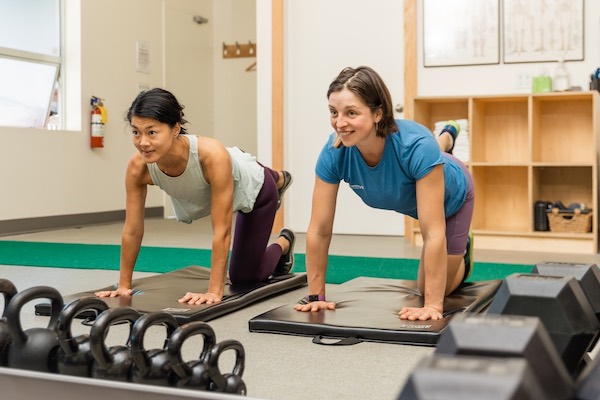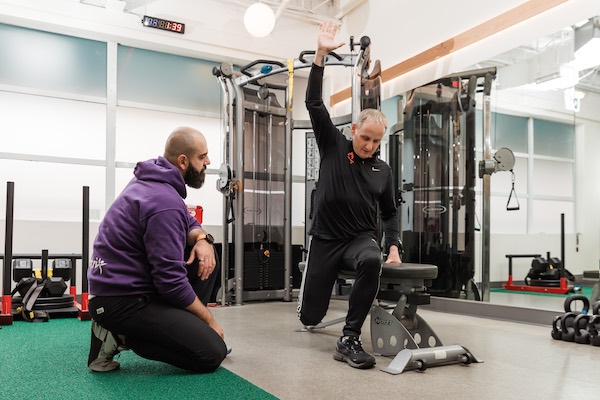Sitting in front of a computer for long periods of time for work can wreak havoc on your muscles, especially those of the upper back, shoulders and neck, and leave them sore and tight at the end of the day. Let’s be honest, our bodies aren’t designed to sit behind a screen day in and day out. But for a lot of us who work desk jobs, sitting all day is part of the job description.
Aside from tackling your work environment such changing your screen or desk height (pssst. We do ergonomic assessments at Symmetrix), there is a simple tool that you can use to help relieve some tension in your upper back throughout your workday.
Enter the foam roller. A foam roller is a cylindrical object that comes in multiple sizes, textures, and firmnesses that you can get at any fitness shop (and even department stores these days).
A foam roller is what we call a ‘myofascial release’ tool which means it helps loosen a tissue in your body called fascia, a spider web-like connective tissue that covers most of your muscles, bones, organs and vessels and that plays an important role in the support and function of your body.
As a kinesiologist I help clients improve mobility by targeting fascia for better function. Foam rollers allow my clients to release tight areas of your body, also known as ‘trigger points’ to help reduce pain. And for the shoulder/neck area, a foam roller can even help with tension-induced headaches.
So how does this magical roller do this? What happens in the body?

What does a foam roller do?
- it applies pressure (when you lie/sit on it) to the fascia and muscles in your body elongating the fibers in targeted areas, and aligns the fibers making them easier to slide against each other
- Mechanical pressure on the tissue makes your nervous system reduce tone (the amount of tension in muscles) globally in the area
- You move fluid such as blood and nutrients towards your muscles which feeds and hydrates them
What are the benefits of using a foam roller?
- Reduced soreness/tightness in the muscles you are rolling
- Muscles that you aren’t rolling but are adjacent also get less tight
- Your muscles are better able to recover from injury by aiding the repair process
- Promotes relaxation (just generally!)
- Improves your circulation and elasticity of the muscles and fascia
What’s the connection between sitting and upper back and neck pain?
- Sitting can cause tension in the upper fibers of the trapezius, which is a muscle that runs up the top of the shoulders and into the neck. Tension often builds up when we shrug our shoulders and can cause headaches and shoulder pain.
- Staying in one position for a long time, often we sit with our heads forward and shoulders rounded. That position tightens the pecs (our chest) and weakens the back such as paraspinals, rhomboids, and traps
When and how often should I foam roll my back?
Although foam rolling is associated with exercise (doing it before or after a workout), you can foam roll your muscles at any time. The best way to incorporate rolling in your day is to have a roller accessible in your home or office. Keep it beside your desk for when the shoulders start to tighten up after sitting in front of the computer. The friction and pressure applied with the foam roller can help warm up and relax the muscles in your back (this reason is also why you can roll before a workout), and helps pump blood and therefore nutrients to your muscles, preventing soreness later on in your day. Foam rolling can provide benefits to you even when you aren’t coupling it with exercise, such as when you use a roller during the work day.
Foam rolling top tips
The best type of roller is on the firmer side, with as much pressure as you can tolerate. Muscle tenderness is okay when you roll, however if you are experiencing bruising after rolling, it’s too hard! Roll one muscle/area for about 30-120 seconds, where the intensity of a single rolling movement should be moderate for about 3 seconds. Don’t shy away from particularly tender areas, and you can definitely take a break and return to the same area up to 3 times in a rolling session.
Foam rolling works best when you break up the muscles you are rolling into smaller increments. Spend 10-15sec on one segment and then move up or down along the muscle. Muscles are the best recipients for being rolled as they are most susceptible to having force applied to them-therefore stay away from bony parts or joints when rolling as you won’t get as good of a release.
In the office, use time on the roller as ways to add micro breaks into your work day. And while you are at it, walk around the office or grab a drink of water!
Foam roller exercises
If you are brand new to rolling, not to worry! I’ve hand-picked some of my favorite foam roller exercises for when I’m working at my desk.
Exercise 1) Upper back rolling

- Lie on your back with your legs bent, heels on the floor
- Place the roller at the base of your ribcage just below the shoulder blades
- Support your head and neck with your hands
- Gently lift your hips off the floor and put your weight on your heels
- Roll back and forth up your upper back, making sure not to roll into the neck or low back
- Bring your elbows together to open up the back a bit more
Exercise 2) Lats insertion

- Lie on your side with your lower arm outstretched by your ear
- Place the foam roller in the armpit region, a bit closer to the ribs than the shoulder joint
- Either rock your body forward and back with small movements or push off with your legs to gently roll up and down (+/- 5cm)
Exercise 3) Pectoral stretch

More of a stretch but I’ve added it because it uses a roller and really works
- This can be done on a long roller or 2 rolled up yoga mats or a firm blanket
- Lie on your back with your head and hips supported by the roller, the roller will be parallel with your spine
- Keep your legs bent with the feet on the floor for balance, a little wider than hip width apart
- Bring your hands together in front of you, arms outstretched
- Open your arms into a big T shape, letting the shoulders relax over the roller
- Raising your arms closer to your ears will increase the stretch in the chest, lowering the arms will reduce intensity
What type of foam roller should I use?
Foam rolling can be tender at first, so I’d recommend easing into it. Shorten the time you roll or choose a softer roller to begin with. Some rollers have large knobs/spikes on them which makes them even move targeted, however I would recommend if you are just starting with rolling to find one with a smooth or lightly textured surface. If rolling is particularly painful, start with just rolling around the particular tender part, or ask your kinesiologist if rolling is right for you.
Conclusion
Foam rollers have been shown to provide a variety of benefits for people with back pain. There are many different types and sizes of foam rollers, so be sure to choose the one that is right for you. Use our foam roller tips and exercises to help relieve tension in your back and improve your overall well-being. If you want more information, or you continue to experience back pain, consider a consultation call with a kinesiologist. Find out more about kinesiology here.
Happy rolling!




.jpg)



